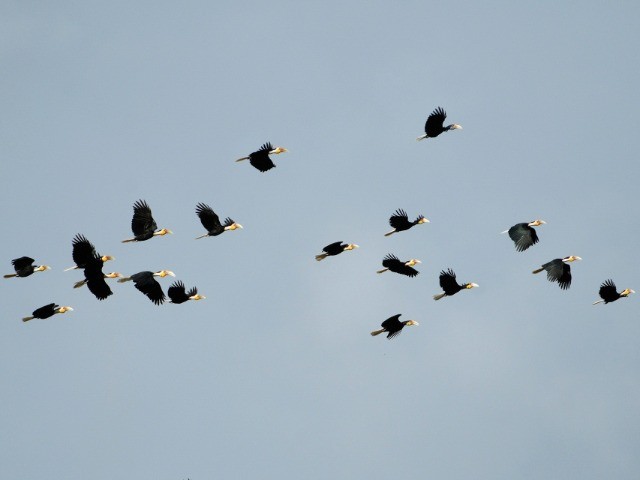This is the fifth story in a series of articles on the Western Ghats—covering everything from elusive frogs to majestic birds to hidden ancient forests.
Among many intriguing things about hornbills and their ecology, I am most fascinated by their nesting habits and behaviour. Unlike the majority of the birds that we are familiar with, hornbills do not build their own nests. They are secondary cavity nesters, using existing holes in tree trunks for nesting. The female hornbill incarcerates herself in the cavity for about four months to lay eggs and raise the chicks, while the male fetches food for the inmates. What is even more fascinating is how hornbill pairs use the same nest over years of breeding. A single tree could bear witness to multiple generations of hornbills successfully fledgling out of its cavity-turned-nest! I was curious to know for how many years they may use the same nest, provided the cavity was still usable.
My hornbill affair began back in 2015. As a master’s student, I decided to investigate if habitat modifications impact the breeding behaviour and nesting success of Great Hornbills in the Anamalai Hills (with the ambitious idea of identifying tens of nests for observation). But little did I know about how to locate these nests in the first place. I landed in the Valparai plateau in the heart of the Anamalai Hills in the southern Western Ghats and decided to scout places where hornbills have been seen in the past. Along with Murthy—who has been with the Nature Conservation Foundation (NCF) for over two decades—I decided to go to a known hornbill roosting site, nestled inside a coffee plantation and not far from the adjacent Anamalai Tiger Reserve.
We were marching through the coffee plantation when I heard a whooshing sound coming closer and passing by above the canopy. Here they were! My study species—the Great Hornbill. On reaching the roosting site, I was thrilled to find more than thirty Great Hornbills flocked together on two trees. After observing them for an hour, I saw that the hornbill pairs were separating from the larger flock. On closer inspection, we realised they were mating pairs searching for a nesting tree. We decided to follow them to try and trace the nest locations. Again, without imagining how difficult it would be, given the differences in our pace. A hornbill pair would fly past a mountain or hill in less than a minute; however, it would take us the entire day as we walked in the same direction the pair had flown in the morning. Thanks to previous studies from the region that had already documented the nest locations, I didn't have to exhaust myself in chasing after Great Hornbill pairs. I studied eight hornbill nests to understand their behaviour in the Anamalai Hills.
Going forward, I was keen to understand what the longevity of a nest used by hornbills could be. By then, I had broadened my scope to three species of hornbills that inhabit the forests of Anamalai Hills—Great Hornbill (Buceros bicornis), Malabar Grey Hornbill (Ocyceros griseus) and the Malabar Pied Hornbill (Anthracoceros coronatus). I decided to find records of previously known nests and revisit them to know if they were still in use. From field notes, PhD theses, reports and scientific papers, I could find details regarding a few nesting locations, thanks to my senior researchers, Dr Ragupathy Kannan, Dr Divya Mudappa and Dr Amitha Bachan K H, who had extensively studied the forests of Anamalai Hills in Kerala and Tamil Nadu. The oldest known nests to Dr Ragupathy Kannan date back to 1991, even before I was born!
Information on the historical nest locations within the vast expanse of the Anamalai rainforest was at hand, yet, finding the nests was far from easy, owing to the high density of large and tall trees in the forests. I decided to talk to local people who live in and around the forests, such as the Kadars, forest department staff, workers in plantations and senior researchers, for additional details on nesting sites. I was fortunate to meet people who were directly involved in helping researchers before, but it had been at least two decades since they had last visited the nest locations. Some were too old to walk in the forest, and some had lost memories of such sites. Those who could accompany me on this excursion were the present-day treasurers of the natural history of these rainforests. There was so much to learn from them about the forests, people and, of course, the hornbills.
As expected, reaching the nests was not easy. This search took us through some of the most beautiful and untouched patches of forests in the Anamalai Hills, which were remote and simply impossible to access via road. We trekked through riparian forests along the roaring River Chalakudy to revisit the four nests of Malabar Pied Hornbills known to researchers since 2000. I was delighted to find that all four nests were still under use, and we even got lucky with sightings of a male hornbill feeding the female at one of the nests. Great Hornbill nests were mostly located deep inside the forest, and we had to trek for an entire day or two to reach some of them. We crisscrossed through dark rainforests, mystical Myristica swamp forests and moist deciduous forests within the Parambikulam and Anamalai Tiger Reserves. After scouring deep inside forests for Great Hornbill nest sites, finding Malabar Grey Hornbill nests in the middle of tea plantations in the Valparai plateau was a pleasant surprise.
You may also like to read
By the end of this exercise, I had visited 120 nests of three different hornbill species. As one would imagine, the largest species, the Great Hornbill, nested in large trees with a girth size wider than four meters. On average, nest cavities of Great Hornbills stood at about 20 meters high, whereas Malabar Grey Hornbills occupied cavities at about 15 meters from the ground. We found hornbills nesting in 34 different tree species. But out of 120 nests I visited, only 50 per cent were in use. Some trees had fallen over, and some cavities were no longer suitable for nesting. Five Great Hornbill nests from the Anamalai Tiger Reserve were in use even after 27 years! The oldest known Malabar Grey Hornbill nests were 25 years old! We also found many nests inside plantations.
The most famous Great Hornbill nest in the Valparai plateau was one of the oldest within a modified habitat. It was first observed in 2008 and has witnessed the successful fledging of Great Hornbill chicks every year since then. Large numbers of bird enthusiasts and wildlife photographers would line up under the nesting tree every year. Colleagues at NCF would joke that it is the most photographed male Great Hornbill in the world! Unfortunately, this iconic tree fell in the torrential rains of 2018.
Hornbill ecologists around the world continue their adventures to understand and conserve hornbill nesting sites in various landscapes, and efforts to restore nest cavities have been successful in India and Southeast Asia. Interventions such as installing artificial nest boxes also seem to have worked for various species in Southeast Asia. However, hornbills in the Western Ghats and the Eastern Himalayas have not accepted artificial nests as yet.
Our research findings highlight the importance of each nesting tree for hornbills. Nesting trees remain one of the critical resources for these unique avians. The declining populations of the Malabar Grey Hornbill in the region could potentially be linked to the reduction in the proportion of active nests. Further studies would help discern the role of other factors, such as changing climatic conditions, nest availability, competition among cavity-nesting birds, and so forth. At the same time, nest sites inside plantations suggest the adaptability of these species to their changing habitats, and long-term impacts remain to be unearthed in the future.
Watch the mini-documentary on Great Hornbills here:











